HOW TO FIND THE EQUATION OF A CUBIC FUNCTION FROM A GRAPH
All cubic are continuous smooth curves. Every cubic polynomials must cut the x-axis at least once and so at least one real zero.
Cubic Equation with Three Distinct Roots
For a cubic of the form
p(x) = a (x - p)(x - q)(x - r)
the graph has three distinct x-intercepts corresponding to the three real. The distinct zeroes are p, q and r.
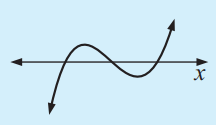
Cubic Equation with Repeated Roots
For a cubic of a form
p(x) = a (x - p)2(x - q)
the graph touches the x-axis at the repeated zero p and cuts it at the other x-intercept q as shown.
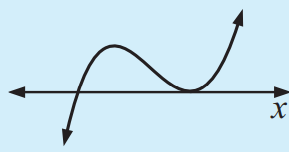
For a cubic of a form
p(x) = a (x - p)3
the graph touches the x-axis at p. The graph is horizontal at this point and the x-axis is a tangent to the curve, even though the curve crosses over it.
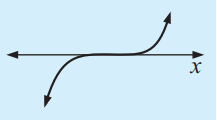
Cubic Equation with No Real Roots
For a cubic of the form
p(x) = a(x - p) (ax2 + bx + c)
where Δ < 0, there is only one x-intercept p. The graph cuts the x-axis at this point. The other two zeroes are imaginary and so do not show up on the graph.
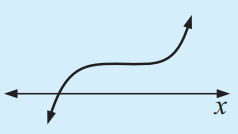
Find the equation of the cubic with the graph.
Problem 1 :
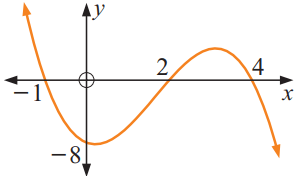
Solution :
x - intercepts :
x = -1, x = 2 and x = 4
Converting into factors, we get
(x + 1) (x - 2) (x - 4)
The required cubic function will be
y = a (x + 1) (x - 2) (x - 4)
We observe that the curve is passing through the point (0, -8).
-8 = a(0 + 1) (0 - 2) (0 - 4)
-8 = a(1)(-2)(-4)
-8 = a(8)
a = -1
y = -1 (x + 1) (x - 2) (x - 4)
Converting into standard form,
y = -1(x + 1)(x2 - 6x + 8)
y = -1(x3 - 6x2 + 8x + x2 - 6x + 8)
y = -1(x3 - 5x2 + 2x + 8)
y = -1x3 + 5x2 - 2x - 8
Problem 2 :
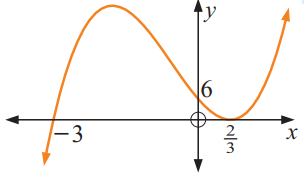
Solution :
x - intercepts :
At -3, the curve crosses the x axis, at 2/3 the curve touches the x-axis. So, we have repeated factors.
x = -3, x = 2/3 and x = 2/3
Converting into factors, we get
(x + 3) (x - 2/3) (x - 2/3)
The required cubic function will be
We observe that the curve is passing through the point (0, 6).
Recent Articles
-
Finding Range of Values Inequality Problems
May 21, 24 08:51 PM
Finding Range of Values Inequality Problems -
Solving Two Step Inequality Word Problems
May 21, 24 08:51 AM
Solving Two Step Inequality Word Problems -
Exponential Function Context and Data Modeling
May 20, 24 10:45 PM
Exponential Function Context and Data Modeling